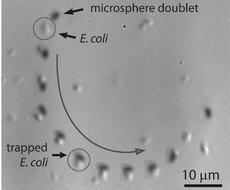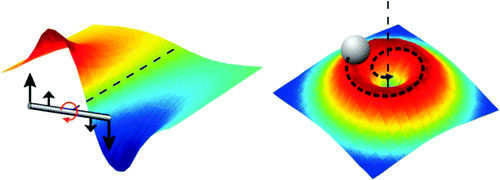Mobile microvortex holds on to bacteria
Researchers at ETH Zurich have used nanowires to create minuscule vortices with which they were able to capture individual microscopic objects such as bacteria and move them precisely across a surface. The new method ends a 90-year search.

The idea could have occurred to a researcher in the bath or while washing up: pulling the plug out of the drain often creates whirlpools that pull everything down the drain that enters the suction. Researchers in the group led by Bradley Nelson, a Professor at the Institute of Robotics and Intelligent Systems and Head of the Multi-Scale Robotics Laboratory, have now exploited the power of these vortices. However, the scientists generated the vortices in a wafer-thin film of liquid under a microscope rather than in a sink.
The researchers used rotating nickel nanowires only 200 nanometres in diameter and 13 microns long to generate the vortices. A weak rotating magnetic field was needed to make the nanowire rotate. This formed a vortex with a diameter of 20 microns, three times thinner than that of a human hair.
Vortex sucks objects in
To generate the vortices, the scientists also used rotors consisting of two microspheres one micron in diameter that self-organised to form a doublet. Both types of rotor – the nanowire and the doublet – created vortices powerful enough to suck in small objects and hold on to them.
However, instead of the vortices being stationary, the researchers were able to move them at will across a surface by reorienting the magnetic field driving the rotors. This allows the plane of rotation of the nanowire to be changed from horizontal to vertical, and the rotors are driven near the plane. This drive mechanism also functions along walls, enabling the scientists to move the vortex and the trapped object trapped over a step.
Physical properties are of secondary importance
Using this technique, the ETH Zurich researchers were able to create multiple vortices and, thus, control several objects simultaneously. Another major advantage of this method is that the vortices can hold on to objects regardless of their physical properties. The object does not need to have any special magnetic, electrical or optical properties.
Brad Nelson also regards this work as a breakthrough. “Research experts have long been interested in the ability to manipulate microscopically small objects like cells individually. We can now demonstrate for the first time that this is possible regardless of their physical properties.”
The controlled handling of tiny objects has a long history. As early as 1922, Alfred Heilbronn at Münster University’s Botanical Institute proposed using magnetic microspheres with magnetic fields and field gradients to manipulate nano-scale structures inside cells. Optical “traps” operating with lasers were developed in the 1970s. Scientists have for some time also used electrophoresis, which is based on electrical fields and is able to separate molecules of various sizes and with different electrical charges. However, the disadvantage of lasers or electrical fields is that they can damage biological sample materials.
Biological specimens remain intact
The new microvortex method does not suffer from this disadvantage – biological specimens remain intact. Thus Bradley Nelson sees potential applications primarily in the field of cell biology studies, especially research into cell properties requiring the observation and manipulation of individual cells. The flows and small forces generated by the microvortices are could be used, for example, to influence the growth of muscle cells or to deform red blood cells, which affects their chemical functions. The new method also allows parallel studies on large working volumes without the need to modify the experimental setup.
Literature reference
Petit T, Zhang L, Peyer KE, Kratochvil BE & Nelson BJ. Selective Trapping and Manipulation of Microscale Objects Using Mobile Microvortices. Nano Letters, doi:10.1021/nl2032487








READER COMMENTS